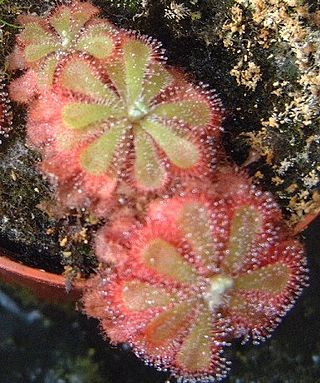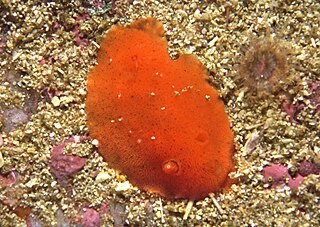
Drosera aliciae, the Alice sundew, is a carnivorous plant in the family Droseraceae. It is native to the Cape Provinces of South Africa, like Drosera capensis, the cape sundew, and is one of the most common sundews in cultivation. The plant forms small, tight rosettes of wedge-shaped leaves, up to 5 cm in diameter. Under conditions of good lighting, the insect-snagging tentacles will become deeply coloured with anthocyanin pigments, which probably aid in its attraction of insect prey. The plant is relatively easy to grow, and produces attractive scapes of pink flowers, which are held about 30 cm away from the carnivorous leaves, so as to prevent pollinators from becoming ensnared. D. aliciae is very similar in form to a number of other closely related species such as D. slackii, and D. natalensis: the former is rather larger with a slightly different growth habit(8 cm diameter); the latter has hairier stipules and a larger distance between leaf base and the “sticky” trichomes.
Nyctibatrachus aliciae is a species of frogs in the family Nyctibatrachidae endemic to the southern Western Ghats in Ponmudi and Athirimala in Kerala, India. These frogs occur in riparian habitats and in streams in tropical moist evergreen and semi-evergreen forests, tolerating some degree of habitat modification. The species, though locally common, has a small distribution are and is threatened by habitat loss.

Discodorididae is a taxonomic family of sea slugs, specifically dorid nudibranchs, marine gastropod mollusks in the superfamily Doridoidea.
Navia aliciae is a species of plant in the genus Navia. This species is endemic to Venezuela. It was first described by Lyman B. Smith and Harold Robinson.
Enteromius aliciae is a species of ray-finned fish in the genus Enteromius. It has been reported only from two locations in Saint John River, Liberia, and Saint Paul River, Guinea; and is threatened by siltation of its habitat, consequent upon deforestation.
Glyphostoma aliciae is a species of sea snail, a marine gastropod mollusk in the family Clathurellidae.

Pocillopora is a genus of stony corals in the family Pocilloporidae occurring in the Pacific and Indian Oceans. They are commonly called cauliflower corals and brush corals.

Eburia quadrigeminata, the ivory-marked beetle or ivory-marked borer, is a species of beetle in the family Cerambycidae. Adult beetles are 12–25 millimetres (0.47–0.98 in) in length. The life span is 10–40 years.

Eburia is a genus of beetles in the family Cerambycidae.
Eburia baroni is a species of beetle in the family Cerambycidae that is endemic to Mexico.
Eburia bimaculata is a species of beetle in the family Cerambycidae found in Antigua and Barbuda.
Eburia charmata is a species of beetle in the family Cerambycidae that is endemic to Brazil.

Eburiini is a tribe of beetles in the subfamily Cerambycinae, synonymous with the tribe Heteropsini Lacordaire, 1868, containing the following genera:
Heteropsini is a tribe of beetles in the subfamily Cerambycinae, synonymous with the tribe Eburiini Blanchard, 1845, containing the following genera:
Cooksonia aliciae is a butterfly in the family Lycaenidae. It is found in Malawi.

Warrenisuchus is an extinct genus of temnospondyl amphibian from the Early Triassic of Queensland, Australia. It belongs to a diverse group of Triassic temnospondyls called Capitosauria. The type species Warrenisuchus aliciae was erected in 2009. W. aliciae was originally described as a species of Parotosuchus in 1988, which is known from other species that have been found in Europe, Africa, and Antarctica. In 2000 it was then assigned to a new genus called Rewanobatrachus along with the newly named species R. gunganj, which was declared the type species of the genus. However, R. gunganj was later reclassified as a species of Watsonisuchus, invalidating the name Rewanobatrachus and requiring that R. aliciae be placed in its own genus, which was named Warrenisuchus. However, several studies suggest that Warrenisuchus aliciae may be a species of Watsonisuchus as well. Unlike most capitosaurs, Warrenisuchus is known from many juvenile skulls less than 4 centimetres (1.6 in) in length.

Eburia haldemani is a species of long-horned beetle in the family Cerambycidae. It is found in Central America and North America.
The southern leatherside chub is a species of freshwater ray-finned fish from the family Cyprinidae, the carps and minnows. It is endemic to Utah in the United States. It is found in slow-flowing pools and backwaters, usually over substrates consisting of mud or sand, of creeks and small to medium-sized rivers. Within Utah, this species is found on the southeastern margins of the Bonneville Basin; it has been recorded from the American Fork, Provo River, and Spanish Fork drainages of the Utah Lake Basin and the San Pitch River, East Fork Sevier River, Beaver River, and the lower, middle, and upper Sevier River drainages of the Sevier River Basin; it has now apparently been extirpated from the Provo River at Utah Lake and from the Beaver River. It is threatened by the fragmentation of its habitat caused by water abstraction for irrigation, damming, urbanization, and poor farming practices. It is also threatened by introduced predatory fish such as the brown trout.

Andrena aliciae, the yellow-faced miner bee, is a species of miner bee in the family Andrenidae. It is native to North America.






